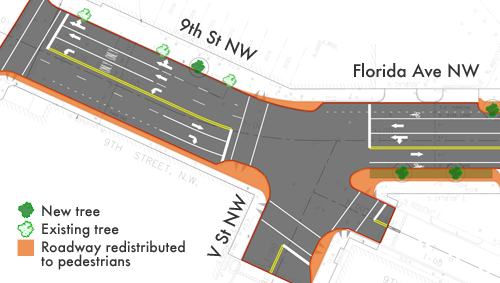Florida Avenue gets closer to a “complete street”
DDOT has developed 3 options to redesign 9th Street and Florida Avenue, NW from U Street to just past Sherman Avenue. All make the road move closer to being a complete street, but also leave a few disappointing gaps.
All 3 options widen the notoriously narrow sidewalk on the east side of 9th Street between U and V Streets. All 3 options also redistribute sections of the right-of-way to pedestrians, cyclists, and permeable surface.

Intersection of 9th, Florida, and V Street in Option 3.
Option 3 stands out as the best option. Its most notable feature is to reconfigure the intersections with Vermont Avenue and Sherman Avenue to traditional right angles. Currently, the intersections are designed like highway ramps to aid drivers in speedy turns between the avenues. As expected, when you engineer a road for fast driving, people will drive fast regardless of the speed limit signs.
To discourage speeding, option 3 curves both of these avenues to intersect Florida Avenue a right angles. This will require sharper turns that will calm traffic and reduce the distances pedestrians must traverse to cross the avenues.
The elimination of the high-speed turn lanes creates the opportunity for two small plazas at these intersections.
Option 3 also reduces the amount of impervious surface (orange) and allows for a planting strip with trees on the east side of Florida Avenue just south of Vermont Avenue. Furthermore, it includes for curb extensions that reduce the distance pedestrians must spend in the path of traffic when crossing the streets.
Bike lanes will extend from Sherman Avenue to 9th Street and will connect the bike lanes on V Street, W Street, and Sherman Avenue.
These changes are very welcome, but there are several regrettable omissions. The intersection at V Street lacks a crosswalk on the north side, as does the north side of the intersection of Vermont Avenue. The intersection with W Street lacks any crosswalks for crossing Florida Avenue at all.
To cross Florida at W, a pedestrian will have to detour nearly 900 feet to and from the nearest crosswalk, or cross without a marked crosswalk. Under DC law, any edge of an intersection is still a legal crosswalk, but by avoiding striping one, DDOT is sending a signal that it isn’t designing the intersection to be safe to cross.
As Howard University increases the number of students living on campus while encouraging walking and biking, the city must build the infrastructure that makes walking safer, easier, and more comfortable.
Curb extensions and crosswalks at W Street would provide an excellent pedestrian accommodation, yet options 1 and 2 show one isolated curb extension at W Street and option 3 shows none.
In 2009, DDOT agreed to add a crosswalk to a Fort Totten intersection which had a missing leg. Including safe crossings at all intersections in street designs should be one of the ways DDOT follows through on its “complete streets” policy.
Another disappointment is that DDOT’s 3 design proposals ignore the roundabout envisioned in the Office of Planning’s Duke Plan.


Left: Intersection of Florida and Sherman today.
Right: Older plan for the intersection with extended Bryant Street.
A roundabout would lie at the intersection of Florida Avenue, Sherman Avenue, and a newly created Bryant Street, which would be constructed on a DC-owned parking lot that lies east of the intersection.
DDOT staff will present this design and take questions at tonight’s meeting of the ANC 1B Transportation Committee. The meeting starts at 7 pm at the Thurgood Marshall Center, 1816 12th Street NW.


